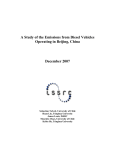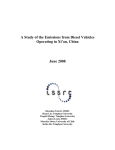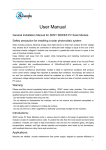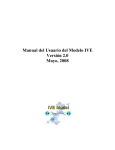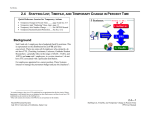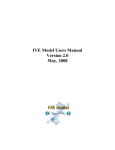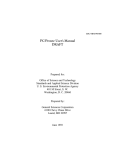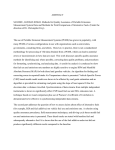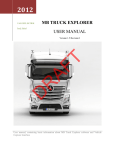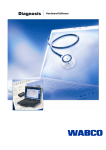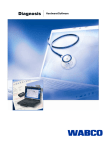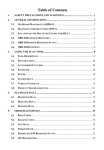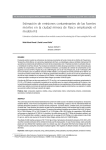Download A Study of the Emissions from Diesel Vehicles Operating in Istanbul
Transcript
A Study of the Emissions from Diesel Vehicles Operating in Istanbul, Turkey January 2007 James Lents, ISSRC Alper Unal, EMBARQ Nizamettin Mangir, City of Istanbul Mauricio Osses, University of Chile Sebastian Tolvett, University of Chile Onder Yunusoglu , City of Istanbul ii Table of Contents I. Introduction II. Testing Procedure III. Measurement Error IV. Overall Results V. Vehicle Emissions Under Different Driving Conditions VI. Emission Comparisons with the IVE Model Appendix A: Field Manual for Diesel Vehicle Testing 1 2 5 6 9 12 A.1 List of Tables Table 1: Diesel Vehicles Tested During the Study Table 2: Estimation of Expected Variation in Test Data for Repeated Driving Cycles Table 3: Overall Emission Measurement Results for the Tested Istanbul Diesel Fleet Table 4: Estimation of Hot Start Emissions for Tested Fleet Table 5: Potential Adjustment Values to be Used in the IVE Model Table 6: Recommended Adjustment Values for Use in the IVE model 1 5 7 8 14 15 List of Figures Figure 1: ISSRC Field Dilution Device Figure 2: Flow Diagram for the Overall Emissions Testing System Figure 3a: Exterior of Bus Outfitted for Emissions Testing Figure 3b: Interior of a Bus Outfitted for Emissions Testing Figure 4: Emissions Averaged Over Selected Model Years for Heavy Duty Vehicles Figure 5: Emissions Averaged Over Selected Model Years for Light Duty Vehicles Figure 6: Comparison of Emissions from Different Vehicle Types Figure 7a: CO2 Emissions From Heavy Duty Vehicles by IVE Bin Figure 7b: NOx Emissions From Heavy Duty Vehicles by IVE Bin Figure 7c: PM Emissions From Heavy Duty Vehicles by IVE Bin Figure 8a: CO2 Emissions From Light Duty Vehicles by IVE Bin Figure 8b: NOx Emissions From Light Duty Vehicles by IVE Bin Figure 8c: PM Emissions From Light Duty Vehicles by IVE Bin Figure 9: Comparisons of Measured Emission Rates with IVE Predicted Emission Rates 3 4 4 5 8 9 10 10 11 11 12 12 13 14 iii Introduction From October 31 to November 17, 2006 a series of 42 diesel vehicles were tested in Istanbul Turkey. 29 of these vehicles were classified as light-duty vehicles varying from passenger cars to smaller delivery vans. The tests were carried out in Istanbul at a service garage operated by the City of Istanbul. Table 1 indicates the vehicles that were tested. Table 1: Diesel Vehicles Tested During the Study Engine Odometer Size (km) (cm3) Test Number Date Vehicle Type Model Year Weight (kg) 1 10/31/2006 Light Duty Truck Hyundai H 100 2.5 TCI 2006 4698 1670 2 10/31/2006 Light Duty Truck Hyundai H 100 2.5 TCI 2006 23208 1805 3 11/1/2006 Light Duty Truck Hyundai H 100 2.5 TCI 2006 2476 10314 1805 4 11/1/2006 Light Duty Truck Hyundai H 100 2.5 TCI 2006 2476 10533 1670 5 11/1/2006 Light Duty Truck Desoto AS 250 1996 2500 >100000 2300 6 11/2/2006 Light Duty Truck Tata Telcoline 4x2 2005 1948 60112 1700 7 11/2/2006 Truck Hino 2001 4009 89358 4400 8 11/2/2006 Minibus Mercedes Sprinter 412D 1999 2874 >100000 2220 25479 2636+4864 2500 >100000 3500 9 11/2/2006 Truck Isuzu NPR 66 2005 10 11/3/2006 Light Duty Truck Ford Transit 1997 11 11/6/2006 Light Duty Truck Levent L100 2006 >100000 1885 12 11/6/2006 Light Duty Truck Desoto 1985 >100000 2240+1260 13 11/6/2006 Passenger Car Renault 2005 1461 50929 945 14 11/6/2006 Passenger Car Ford Focus Trend 2006 1560 43990 1245 15 11/7/2006 Bus (Public) Mercedes Citaro 2006 6374 2449 111000 16 11/7/2006 Bus (Public) MAN SL200 1986 >100000 17 11/7/2006 Bus Articulated (Pub.) Mercedes 0345 2000 >100000 18 11/8/2006 Bus (Private) Belde 220CB 2004 >100000 10150 19 11/8/2006 Bus (Private) Belde Euro 2 2005 >100000 10150 20 11/8/2006 Truck Desoto AS 250 1996 87 HP >100000 2300 21 11/9/2006 Truck Mercedes Axor 3028 2006 6374 10396 12320+6374 22 11/9/2006 Truck Fiat 50 NC 1987 >100000 2850+2750 23 11/9/2006 Passenger Car Renault Clio Symbol 1.5 2006 1461 28249 945 24 11/9/2006 Light Duty Truck Fiat Ducato 230 2001 2800 28263 2040+984 25 11/10/2006 Truck Isuzu NQR 70P 2006 5193 626 5460+2041 26 11/10/2006 Light Duty Truck Isuzu NKR Wide 66 2001 4334 65119 3050 27 11/10/2006 Minibus Mercedes Sprinter 308D 1997 79 HP >100000 2005 28 11/13/2006 Truck Mercedes Benz 1997 211 HP >100000 10520+14930 29 11/13/2006 Light Duty Truck Fiat Doblo Combi 1.9 2004 1910 15442 1350+735 30 11/13/2006 Light Duty Truck Fiat Doblo Combi 1.9 2004 1910 10668 1350+735 31 11/13/2006 Minibus Ford Transit 300S 2006 2402 22207 2010 32 11/14/2006 Minibus Ford Otosan 2006 2402 25042 2010 33 11/14/2006 Minibus Volkswagen Transporter 1997 78 HP >100000 1705+995 34 11/14/2006 Minibus (Commercial) Otokar 2006 3770 26982 3660 35 11/14/2006 Truck Fatih 1987 6550 36 11/15/2006 Light Duty Truck Ducato 230 2001 2800 >100000 >100000 1910 >100000 1380 37 11/15/2006 Light Duty Truck Fiat Doblo Cargo 1.9 1 2003 2040 38 11/15/2006 Light Duty Truck Mercedes Benz 312D 1998 2874 >100000 1045+2455 39 11/15/2006 Minibus Ford Transit 100 2000 2490 41502 1530+1180 40 11/15/2006 Passenger Car Renault Clio Symbol 1.5 2006 1461 17813 945 41 11/16/2006 Light Duty Truck Dodge Chrysler 1996 2500 >100000 3500 42 11/16/2006 Light Duty Truck Levent L100 2006 2593 7952 1885+1265 This study was a joint effort of the City of Istanbul, EMBARQ, and ISSRC. The City of Istanbul provided a location for testing, personnel to install testing equipment and procured vehicles for testing. EMBARQ also supplied personnel to support testing and participated in the selection of vehicles for testing. ISSRC provided test equipment and testing expertise for the study. Testing Procedure Vehicles were brought to the test site for test equipment installation. These vehicles were warmed up at the time of the testing. Once emissions testing equipment was installed, the vehicles were operated over a prescribed driving circuit that Istanbul allowed the vehicles to be operated over as wide a range of operating conditions as could be achieved within the city limits of Istanbul. The driving circuit required from 36 to 50 minutes to complete depending upon the traffic situation and included a moderate hill that the vehicles drove over. The typical time to complete the circuit was 38 minutes. For emission measurement purposes, a Semtech Sensor D gas emissions testing unit was used to measure the emissions of CO, CO2, total Hydrocarbons (THC), NOx, and NO2. The Sensor D unit uses infrared absorption technology to measure CO and CO2 , ultraviolet absorption technology to measure NOx and NO2, and a flame ionization detector to measure total hydrocarbon emissions. The Sensor D testing unit is an integrated emissions testing device designed to be used in on-road testing programs. The Sensor D measures emission concentrations and must be provided with exhaust flow rates and ambient temperatures and pressures in order to determine mass emission rates. The Sensor D is equipped with a temperature/pressure sensor. A Semtech manufactured 4 inch (10 cm) exhaust flow measurement device was used to measure the exhaust flow rate from the bus. This device uses standard dynamic and static pressure measurement to calculate exhaust flow. The Sensor D was also equipped with a GPS device to measure location and speed. All data was collected at one second intervals. For further information on the Sensor D test unit and the Semtech exhaust flow device please go to www.sensors-inc.com . The Sensor D test unit was zeroed and spanned at each set of test cycles. The unit was found to be very stable from day to day with the zero and span holding within 1% of the calibration gases. Particulates were measured on a second by second basis using a Dekati DMM testing unit. This unit uses a particle charging process and six stage impactor setup to determine particle mass. The DMM measures particle concentration. The exhaust flow rates collected by the Sensor D unit must be used with the Dekati measurements to determine particulate mass flow rates. The DMM measures particles in the 0 to 1.5 micron range, which is the size range where virtually all diesel particulates reside. The DMM has been found to produce results comparable to the reference particulate sampling methods for diesel particulates; although, it was found to produce readings about 30% high in some cases. Dekati experts believe that this is due to the fact that the Dekati measurement process can measure volatile particulate matter that is lost in the case of 2 filter based particulate sampling devices. For further information on the DMM, please see www.dekati.com. The DMM was zeroed at the beginning of each testing cycle. The charging and impactor units become covered with particulates and must be cleaned after each 2-3 hours of testing to keep the unit operating properly. The DMM can not handle the mass concentrations found in uncontrolled diesel units. Thus, the diesel exhaust must be diluted at a controlled rate in order to use the DMM. A field dilution device was developed by ISSRC to use in on-road emissions testing with the DMM. Figure 1 illustrates the design of the ISSRC field dilution unit. Figure 1: ISSRC Field Dilution Device The exhaust flow in the dilution device is measured using a Dwyer differential pressure transducer, which is accurate to 0.25% of full scale. The differential pressure gauge is used to measure the pressure difference between P2 and P3 shown in Figure 1. A micro-filter produces particle free air to be diluted with the exhaust sample. The exhaust sample and dilution air are heated to 110 degrees C to avoid water and organic condensation. The dilution control can be adjusted to levels from 20 to 1 to 40 to 1 using the ball valve dilution control at the inlet to the micro-filter. Unfortunately, when the exhaust gases flowing through the exhaust flow device increase as the vehicle accelerates, the pressure P1 in Figure 1 drops and the dilution rate changes. Thus, the dilution rate must be monitored second by second and the dilution rates corrected second by second to produce an accurate particulate mass emissions rate. On occasion when testing a large engine under heavy load, the pressure P1 drops so low as to reduce the exhaust flow in the diluter to near zero. This causes the system to under predict particulate emission rates and must be removed in the data analysis process. Figure 2 presents a flow diagram for the overall emissions testing system. The data collected by 3 Figure 2: Flow Diagram for the Overall Emissions Testing System The flow measurement device and the Sensor D are recorded to a flash card on the Sensor D unit. The Dekati information is recorded to a laptop computer that is connected to the Dekati by a serial cable. Figures 3a and 3b show the exterior and interior of a bus outfitted for testing. Figure 3a: Exterior of Bus Outfitted for Emissions Testing 4 Figure 3b: Interior of a Bus Outfitted for Emissions Testing In order to simulate passenger weight, 70 liter plastic water containers were placed on the bus. These containers weighed about 64 kilograms each and thus simulated the weight of a single person. Depending upon the size of the bus, containers were loaded to simulate 30 to 50 bus riders. Measurement Error No measurement process is free from measurement and operating error. Referring to Figure 2, there is the potential for measurement error in the flow measurement process, the dilution rate measurement, the gas concentrations measurement, and the bus operator's ability to follow the desired driving patterns. Table 2 outlines potential error assuming that each process can be held to produce only 2% error to help understand the expected variations in results from the repeated testing. Table 2: Estimation of Expected Variation in Test Data for Repeated Driving Cycles Impact on Gaseous Measurements 2% --2% 4% Measurement Process Exhaust Volume Flow Measurement Dilution Measurement Emissions Concentration Measurement Total Potential Variation 5 Impact on Particle Measurements 2% 2% 2% 6% To further complicate the process, data is collected on normal city streets which results in different driving patterns from test to test. Daily variations in traffic flow have a major impact on how the vehicles can be operated. Thus, emissions can vary considerably from test to even using the same vehicle. To correct for this variation, the data is divided into different power demand categories. 60 power demand categories are used for this purpose. These categories are typically referred to as Power Bins and are numbered from 0 to 59. The distribution of driving in the 60 Power Bins is determined. This driving distribution is multiplied by the average emissions measured in the 60 bins to produce a standardized estimate of emissions that would have resulted if the vehicle had been operated on an FTP cycle. This approach was found in a yet to be published study in Brazil to produce estimates of emissions on the actual driving cycle within 6%. While this is good in many respects, it must be added to measurement uncertainty indicated in Table 2, which results in a potential emissions error of 10-12% overall. The error discussed in the previous paragraphs should be random and thus should average out to some degree over multiple tests. Finally, the number of vehicles that can be tested in a 2-3 week period is limited. This limited testing further decreases the certainty of how will the tested fleet actually represents the actual urban fleet. Based on ISSRC data collected in similar gasoline emissions studies, the collection of data from a fleet of randomly selected gasoline fueled vehicles resulted in 90% confidence interval of plus or minus 20%. When all potential errors are combined, it should be anticipated that this study will produce results which are to a 90% probability to within 25-30% of the actual emissions produced by the local fleet. While this potential error is larger than preferred, it is still better than using emission estimates derived from studies in the U.S. and Europe. In the long run, more emissions tests are required in order to reduce the mobile source inventory uncertainty to the 10% range. Overall Results Table 3 presents the average emissions measured for the various vehicles tested in the program. They are listed in the order tested. An average value and 90% confidence limits are also included. The 90% confidence interval in Table 3 indicates the range of emissions for which there is a 90% probability that the true mean emission rate of the fleet would exist if the tested vehicles were randomly selected from the Istanbul fleet. The vehicles tested should be somewhat representative of the Istanbul fleet, thus, the measured values are likely within 20-25% of the true mean of the Istanbul fleet. 6 Table 3: Overall Emission Measurement Results for the Tested Istanbul Diesel Fleet Test Date Tested Number Vehicle Type Measured Emissions (grams/kilometer) Year FTP Normalized Emissions (grams/kilometer CO2 NOx PM CO THC CO2 NOx PM CO THC 1 10/31/2006 Light Duty Truck 2006 290 1.26 0.011 0.00 0.18 214 1.09 0.008 0.00 0.11 2 10/31/2006 Light Duty Truck 2006 361 1.48 0.066 0.00 0.39 259 1.19 0.046 0.00 0.25 3 11/1/2006 Light Duty Truck 2006 343 1.02 0.045 0.71 0.16 264 0.95 0.035 0.56 0.11 4 11/1/2006 Light Duty Truck 2006 292 0.000 0.94 0.25 270 0.82 0.000 0.81 0.22 5 11/1/2006 Light Duty Truck 1996 602 0.96 13.5 0.134 2.55 1.83 385 10.14 0.085 1.63 1.02 6 11/2/2006 Light Duty Truck 2005 292 1.24 0.055 0.21 0.07 235 1.06 0.043 0.16 0.06 7 11/2/2006 Truck 2001 451 2.99 0.105 3.04 1.57 363 3.13 0.087 2.51 1.11 8 11/2/2006 Minibus 1999 303 1.22 0.142 1.37 0.38 242 1.24 0.114 1.09 0.26 9 11/2/2006 Truck 2005 559 4.43 0.146 2.92 1.37 372 3.80 0.100 1.98 0.76 10 11/3/2006 Light Duty Truck 1997 367 4.14 0.084 0.91 0.70 243 3.27 0.054 0.61 0.38 11 11/6/2006 Light Duty Truck 2006 349 3.20 0.032 2.16 1.58 293 2.73 0.027 1.78 1.25 12 11/6/2006 Light Duty Truck 1985 96 2.14 0.151 0.71 0.52 65 1.89 0.103 0.49 0.30 13 11/6/2006 Passenger Car 2005 203 1.73 0.073 1.58 0.23 132 1.39 0.047 0.99 0.12 14 11/6/2006 Passenger Car 2006 234 1.23 0.188 0.28 0.02 168 0.88 0.114 0.17 0.01 15 11/7/2006 Bus (Public) 6.75 0.67 857 10.09 0.076 4.85 0.41 16 11/7/2006 4.26 2.46 674 13.33 0.299 3.13 1.47 17 11/7/2006 2006 1198 11.41 0.105 Bus (Public) 1986 949 14.33 0.413 Bus Articulated (Pub.) 2000 1574 20.88 0.025 1.60 1.06 1212 19.66 0.020 1.24 0.71 18 11/8/2006 Bus (Private) 2.33 1.34 669 11.66 0.413 1.45 0.66 19 11/8/2006 Bus (Private) 3.71 0.44 579 7.11 0.446 3.12 0.32 20 11/8/2006 Truck 2004 1089 13.43 0.665 2005 701 7.09 0.533 1996 484 14.11 0.112 3.14 1.46 385 15.05 0.091 2.55 0.99 21 11/9/2006 Truck 2006 748 10.06 0.163 2.06 0.27 540 10.16 0.121 1.55 0.16 22 11/9/2006 Truck 1987 448 9.32 0.176 6.70 3.25 253 7.18 0.099 3.83 1.47 23 11/9/2006 Passenger Car 2006 205 1.84 0.000 0.84 0.06 141 1.39 0.000 0.55 0.04 24 11/9/2006 Light Duty Truck 2001 449 4.87 0.147 2.37 0.52 216 3.23 0.071 1.17 0.20 25 11/10/2006 Truck 2006 653 4.54 0.076 2.77 0.51 489 3.98 0.057 2.06 0.33 26 11/10/2006 Light Duty Truck 2001 406 3.65 0.125 2.43 1.56 365 3.99 0.115 2.25 1.25 27 11/10/2006 Minibus 1997 382 1.85 0.141 0.86 0.16 193 1.42 0.072 0.44 0.06 28 11/13/2006 Truck 1997 858 12.03 0.113 4.49 2.27 447 9.97 0.061 2.39 0.91 29 11/13/2006 Light Duty Truck 2004 186 0.98 0.043 0.20 0.11 216 0.98 0.046 0.21 0.13 30 11/13/2006 Light Duty Truck 2004 308 1.41 0.089 0.66 0.13 196 1.05 0.055 0.41 0.07 31 11/13/2006 Minibus 2006 272 1.32 0.132 3.35 0.87 132 0.94 0.065 1.64 0.33 32 11/14/2006 Minibus 2006 241 1.57 0.134 0.65 0.29 152 1.11 0.082 0.40 0.16 33 11/14/2006 Minibus 1997 163 1.32 0.073 0.74 0.11 91 0.82 0.035 0.35 0.05 34 11/14/2006 Minibus (Commercial) 2006 469 5.62 0.126 2.31 0.65 377 5.05 0.104 1.91 0.49 35 11/14/2006 Truck 794 15.61 0.448 10.12 2.97 447 12.68 0.257 5.82 1.35 36 11/15/2006 Light Duty Truck 3.95 90 2.58 0.007 0.85 0.19 37 11/15/2006 Light Duty Truck 0.14 137 1.31 0.021 0.29 0.05 38 11/15/2006 Light Duty Truck 0.49 213 2.08 0.068 1.50 0.28 39 11/15/2006 Minibus 2001 1151 11.60 0.094 10.78 2003 276 1.80 0.042 0.61 1998 312 2.36 0.098 2.17 2000 269 3.02 0.037 1.38 0.36 177 2.45 0.024 0.90 0.20 40 11/15/2006 Passenger Car 2006 82 0.76 0.012 1.19 0.11 45 0.53 0.006 0.65 0.05 41 11/16/2006 Light Duty Truck 1996 456 13.08 0.044 3.00 1.79 215 15.67 0.021 1.43 0.54 42 11/16/2006 Light Duty Truck 2006 389 CO2 3.43 NOx 2.42 CO 1.56 THC 240 CO2 2.47 NOx 0.054 PM 1.41 CO 0.83 THC 1987 0.093 PM Average Values 482 8.54 0.13 2.41 0.92 316 7.36 0.09 1.45 0.47 90% Confidence Interval 17% 16% 27% 25% 26% 18% 17% 28% 22% 24% 7 The first 200 seconds of driving were separated out since there was concern that there could be some start-up emissions from the vehicles. Start-up emissions were estimated by calculating the emissions in the first 200 seconds based on emissions measured in the vehicle test after the first 200 seconds and subtracted from the actual measured emissions. Table 4 indicates the results of this analysis. The values shown in Table 4 are the average values for the total tested fleet and have a large uncertainty since they involve a difference and a correction process. The 90% confidence interval shown in Table 4 is an indicator of this uncertainty. Table 4: Estimation of Hot Start Emissions for Tested Fleet Average Excess Emissions CO2 (grams/start) -19.0 NOx (grams/start) -0.63 PM (grams/start) 0.04 CO (grams/start) 0.45 THC (grams/start) -0.03 90% Confidence Interval 103% 53% 85% 77% 280% A negative number in Table 4 means that the emissions measured after the first 200 seconds were actually greater than the emissions during the first 200 seconds. Only PM and CO showed positive hot start emissions. Little reliance should be placed on these values due to the large uncertainty indicated by the confidence interval. Figure 4 shows the CO2, NOx, and PM emissions from the larger trucks and emissions for three groupings of model years. As can be seen, the data for the newer vehicles are little difference from the older vehicles. This is not surprising with respect to CO2, but is somewhat surprising with respect to NOx and PM. Table 4 represents tests over only 13 vehicles and should thus be considered in that light. Also, two buses, both by the same manufacturer, out of 6 vehicles in the 2004-2006 measured emissions 4 times higher than the other buses. If these two buses are removed from the data set then the emission rate for the newer vehicles is about the same as the 1996-2001 average. 25.0 20.0 15.0 1986 -1987 1996 -2001 10.0 2004 -2006 5.0 0.0 CO2/40 Nox PM*100 Figure 4: Emissions Averaged Over Selected Model Years for Heavy Duty Vehicles Figure 5 shows the CO2, NOx, and PM emissions from the passenger vehicles and smaller trucks tested in the study. These results, which represent 29 tests, show some reduction in emissions from 1986 to 2006; although the improvement is not major. 8 9 8 7 6 1985 -1999 5 2000 -2004 4 3 2005 -2006 2 1 0 CO2/40 Nox PM*50 Figure 5: Emissions Averaged Over Selected Model Years for Light Duty Vehicles The particulate emissions from these vehicles are significant. They are in the ballpark of particulate emissions from the larger diesel vehicles. It is also valuable to consider emissions by vehicle type. These values are shown in Figure 6 for five pollutants of interest. 7 1600 6 1400 5 1200 1000 4 800 3 600 2 400 1 200 0 0 Bus Truck Pickup Truck MiniBus Passenger Vehicle 18 Bus Truck Pickup Truck MiniBus Passenger Vehicle Pickup Truck MiniBus Passenger Vehicle 0.6 16 0.5 14 12 0.4 10 0.3 8 6 0.2 4 0.1 2 0 0 Bus Truck Pickup Truck MiniBus Passenger Vehicle Bus Truck Pickup Truck MiniBus Passenger Vehicle 2.5 2 1.5 1 0.5 0 Bus Truck Figure 6: Comparison of Emissions from Different Vehicle Types 9 As Figure 6 illustrates, the relative magnitude of the emissions were as expected with the buses producing the most emissions and the passenger vehicles the least. Vehicle Emissions Under Different Driving Conditions Another purpose of this study is to determine emissions variation under different driving conditions. These conditions can be represented by the IVE driving bin. The IVE model divides the range of driving situations into 20 vehicle energy demand situations1 and 3 engine stress situations2. Figure 7a, b, and c present emissions from the large diesel vehicles as a function of IVE driving bin. 35 30 25 20 15 10 5 0 1.00 1.04 1.08 1.12 1.16 2.00 2.04 2.08 2.12 2.16 3.00 3.04 3.08 3.12 3.16 Figure 7a: CO2 Emissions From Heavy Duty Vehicles by IVE Bin The emissions look typical with the exception of the apparent fall off in emission rate in stress category 1 and bins 16-18 (i.e. 1.16 to 1.18 in Figure 7). These data points are marked in red. Due to traffic congestion in Istanbul, it is not possible for driving to have occurred in bins 1.171.19. Thus, these data points must result from erroneous classification of data into bins. It has been found that the GPS unit will loose signal and freeze and then jump to the correct speed when the signal returns or miscalculation of altitude. This causes an improperly high acceleration or road slope calculation, which results in the emissions being classified into too high bins. Steps are taken to filter these events out of the data; however, a few data points slip by. The data in bins 1.17-1.19 in Figure 6 represent only 0.02% of the collected data (i.e. about 6 seconds out of 2,600,000 seconds of data) and are included only for the sake of completeness. Figure 7b presents data from the same vehicles but this data is the NOx data from those vehicles. 1 The energy demand on a vehicle is the result of engine and rolling friction, wind resistance, acceleration energy, and road grade. For a further discussion, the reader is referred to the user’s manual for the IVE model, which can be obtained at www.issrc.org/ive . 2 Engine stress relates to engine rpm and the average energy demand on the vehicle in the most recent 15 seconds. The reader is referred to the user’s manual for the IVE model, which can be obtained at www.issrc.org/ive . 10 0.3 0.25 0.2 0.15 0.1 0.05 0 1.00 1.04 1.08 1.12 1.16 2.00 2.04 2.08 2.12 2.16 3.00 3.04 3.08 3.12 3.16 Figure 7b: Emissions From Heavy Duty Vehicles by IVE Bin There is one interesting aspect of this data set. There is data in bins 1.14 and 1.15 that have dropped off even with significant driving in those bins. Thus, the fall off in NOx emissions in bins 1.14 and 1.15 may be a real phenomenon. This characteristic is seen in gasoline data were the vehicles go into an enrichment mode that reduces the combustion temperatures and thus NOx. These vehicles may be doing the same thing. Figure 7c presents the binned data for particulate matter from the large diesel vehicles. This data is more discontinuous than the NOx or CO2 data. A part of this discontinuity may be the extra error induced by the requirement to use a diluter and the change in the performance of the Dekati particulate test unit as it becomes dirty. In any case, the general form of the emissions curve can still be seen in the data. 0.006 0.005 0.004 0.003 0.002 0.001 0 1.00 1.04 1.08 1.12 1.16 2.00 2.04 2.08 2.12 2.16 3.00 3.04 3.08 3.12 3.16 Figure 7c: PM Emissions From Heavy Duty Vehicles by IVE Bin Figure 8a, b, and c present the same data as Figures 7a, b, c except that it comes from the light duty diesels tested in Istanbul. The data points marked in red again represent erroneous data points since no driving could have occurred in these bins. Otherwise, the data looks reasonable for these types of vehicles. 11 9 8 7 6 5 4 3 2 1 0 1.00 1.04 1.08 1.12 1.16 2.00 2.04 2.08 2.12 2.16 3.00 3.04 3.08 3.12 3.16 Figure 8a: CO2 Emissions From Light Duty Vehicles by IVE Bin 0.06 0.05 0.04 0.03 0.02 0.01 0 1.00 1.04 1.08 1.12 1.16 2.00 2.04 2.08 2.12 2.16 3.00 3.04 3.08 3.12 3.16 Figure 8b: NOx Emissions From Light Duty Vehicles by IVE Bin It is difficult to know if there is a similar enrichment in the NOx resulting in emissions reductions in the higher bins in this data set. Figure 8c presents the binned PM emissions. As was the case with the larger diesel vehicles, the binned emissions are more discontinuous compared to the CO2 and NOx emissions. 12 0.0035 0.003 0.0025 0.002 0.0015 0.001 0.0005 0 1.00 1.04 1.08 1.12 1.16 2.00 2.04 2.08 2.12 2.16 3.00 3.04 3.08 3.12 3.16 Figure 8c: PM Emissions From Light Duty Vehicles by IVE Bin The particulate emissions follow the expected pattern on the whole. Emission Comparisons with the IVE Model As noted earlier, 13 large buses and trucks and 29 smaller passenger cars and trucks were tested in Istanbul. This limited data does not provide large enough samples of individual technologies to do an analysis of emission comparisons by technology type. Instead, the IVE model was run using an FTP driving pattern, the pattern used to develop base emission factors for the IVE model, using the distribution of vehicles tested in Istanbul. Two vehicle groups were used. The first was the 13 larger diesel vehicles and the second was the 29 smaller diesel vehicles. The average measured values normalized to FTP driving cycles were divided by the IVE predicted values to evaluate the comparisons. Figure 9 provides the results of this analysis. As can be seen, the CO2 emission projections were accurate producing a ratio close to 13. The other predictions, however, showed a wide variance. The PM values measured were less than those predicted by the IVE model. Differences between actual and measured values were anticipated in the development of the IVE model and provisions are made in the IVE model to add an adjustment file that will adjust the base emission factors to actual measured values. 3 In the case of light duty vehicles the ratio is 0.94. In the case of the heavy duty vehicles the ratio is 0.97. These 36% differences are well within the accuracy of the data collection process. 13 2.50 2.00 1.50 Overall Truck Overall Auto 1.00 0.50 0.00 CO Ratio VOC Ratio NOx Ratio PM Ratio CO2 Ratio Figure 9: Comparison of Measured Emission Rates with IVE Predicted Emission Rates The default base emission factors in the IVE model are based primarily on emission measurements made in the United States and represent test results from thousands of vehicles. It is difficult to know how much weight to give to emission results from only 42 vehicles. However, the confidence limits shown in Table 3 suggest that the results should be in the ballpark of 30% of the measured values. Table 5 shows the actual ratios and the ratios if the measured emission results were modified to be 30% closer to the IVE projected values. Table 5: Potential Adjustment Values To Be Used in IVE Model Class Overall Truck (Heavy Duty Vehicles) Overall Truck Adjusted 30% in direction of default values Overall Auto (Light Duty Vehicles) Overall Auto Adjusted 30% in the direction of default values CO Ratio 0.46 0.60 VOC Ratio 0.70 0.91 NOx Ratio 0.74 0.96 PM Ratio 0.45 0.60 0.72 0.93 0.95 1.23 2.18 1.53 0.70 0.91 Because of the limited number of tests, it is suggested that the values closer to the IVE default values (the 30% adjusted values) be used until more in-use emissions data is collected. A value of 1 is used in the cases where the 30% adjustment takes the values from less than 1 to greater than 1. Table 6 presents the recommended adjustment values for diesel vehicles in Istanbul. These values should, of course, be improved as more data is collected. 14 Table 6: Recommended Adjustment Values for Use in the IVE model Class CO Ratio 0.60 0.93 Overall Diesel Heavy Duty Vehicle Overall Diesel Light Duty Vehicle 15 VOC Ratio 0.91 1.00 NOx Ratio 0.96 1.53 PM Ratio 0.60 0.90 Appendix A Field Manual For Diesel Vehicle Testing A.1 IVE In-Use Vehicle Emissions Study for Diesel Vehicles I. Introduction: Diesel emissions are important contributors to air quality degradation in urban areas. Diesel particulates are considered to be carcinogenic or likely carcinogens in the United States, and diesels are often the prime source of nitrogen oxide emissions. It is thus important that diesel emissions be well understood and that air quality planners be able to predict the impact of diesels in the present time and at times in the future based on specific control scenarios. To support these efforts, a process of on-road measurement of diesel emissions has been devised and the International Vehicle Emissions (IVE) model was developed to estimate emissions from diesel vehicles under different driving and control scenarios. The IVE model is designed to make estimates of in-use vehicle emissions in the full range of global urban areas. At the point in time of IVE model development, data to establish base emission factors and driving pattern adjustments were, of necessity, based on vehicle studies carried out primarily in the United States. This has raised questions as to the applicability of the base emission rates and driving pattern adjustments used in the model to developing countries. The IVE in-use vehicle emissions study is designed to test the hypothesis that similar vehicle technologies will produce equivalent emission results in a given location and to provide some rudimentary data for creating improved emission factors. The IVE modeling framework provides the user with the ability to enter adjustments to the base emission factors that are specific to a location in case the supplied factors are found to be in error. This capability was built into the model to support emission measurement studies that would be made in developing countries as local capacity increases. The IVE In-Use vehicle emissions study is not designed to fully develop correction factors for the IVE model. The original data base used to developed the IVE model correction factors was based on more than 500 vehicle tests each involving three driving cycles carried out at the University of California CE-CERT research facility. This information was combined with summarizations of thousands of in-use vehicle tests provided by the United States Environmental Protection Agency. The IVE In-Use emissions study discussed in the following section results in emissions data for 40 diesel fueled vehicles. Information from 40 vehicles, while significant, does not provide the range of data for the development of a full range of new emission factors and adjustments. Nonetheless, the IVE In-Use emissions study can be used to make rudimentary adjustments to the IVE model that will certainly improve its performance for developing countries. The actual IVE In-Use vehicle emissions study makes use of recently developed emissions measurement technology that can be carried on-board vehicles while they are driven on urban streets. This technology allows emission mass per unit distance to be determined in real driving situations. To date, this on-board emissions measurement technology can be used to measure carbon monoxide (CO), carbon dioxide (CO2), total hydrocarbons (THC), and nitrogen oxides (NOx). A different testing device to measure particulate emissions is also used during the study to establish real-time particulate emissions from the tested diesel vehicles. A.2 The IVE in-use vehicle emissions study is built around a two week study period where on-road vehicle emissions data is collected. II. Equipment Needed to Complete Study A wide range of equipment is required to carry out the diesel emissions study. The key pieces of equipment will be shipped from the United States. However, a significant amount of equipment and supplies must be provided locally. An Excel spreadsheet program is provided with this write-up that indicates the equipment that will be sent from the United States and the equipment that must be procured locally. III. Sample Size and Impact on Emissions Measurement Reliability: Unfortunately for the researcher studying the emissions from on-road vehicles, the variance in emissions among vehicles with similar technologies is quite large. This means that multiple tests on different vehicles are required to accurately establish the true fleet wide average for a given technology. Equation II.1 indicates the 70% confidence interval for data in a Gaussian distribution. I70% = ± σ/√ (n-1) where, I70% = 70% confidence interval σ = standard deviation n = sample size II.1 In the case of vehicular emissions, σ is often close to the sample mean; although diesel vehicles show a little less variation that do gasoline fueled vehicles. In this case, Equation II.1 becomes: I70% = ±[M/√(n-1)] where M = measured sample mean II.2 In this special case, to insure that the measured mean has a 70% probability of being within 15% of the actual mean requires a sample size of 44 vehicles. The actual variation in emissions from similar technologies is unknown but based on the previous discussion it is clear that a relatively large number of vehicles of a given technology class should be tested. For purposes of this study, at least 10 vehicles of each important technology should be measured to insure even a moderate level of confidence in the results. Once the data is collected, the variance in the data of similar vehicles will establish the true confidence that can be placed in the results of the tests. With present vehicle testing technology, about 1.5 hours are required to remove the equipment from one vehicle and install the sampling equipment in a second vehicle. To collect data for ¾ of an hour for a given vehicle will thus require a total of 2.25 hours per vehicle. In a 9 hour day, about 4 vehicles can be sampled. In a two week sampling period (10 sampling days), about 40 vehicles can be studied. Thus, based on the preceding discussion, only four general vehicle technology groups should be studied over the two week sampling period in order to insure at A.3 least 10 vehicles per technology class are studied. The variety of diesel engine technologies operating in most urban areas today are relatively small and the study of the four most predominate vehicle technologies in an area will provide useful data for understanding the overall diesel emissions in an urban area. IV. Sampling Program: Based on Section II, it is desired to study four vehicle technology classes during the two week study. The vehicle technology classes that should be studied are those groups which dominate the local diesel fleet being studied and which will continue to be important in the next 5 years. The vehicles selected may vary from location to location, but based on previous experience, it is suggested that the following four technology classes be considered: 1. 2. 3. 4. Euro 1 type technologies Euro 2 type technologies Euro 3 type technologies Euro 4 type technologies if available or extend testing of most common of the three previous groups. The previous suggested technology classes should not be rigidly adhered to in cases where the local fleet does not contain significant numbers of vehicles in any of the vehicle classes listed. It is best to tailor the study to the makeup of the local fleet. For this paper, the four suggested classes will be used for discussion purposes. Start emissions are important for gasoline vehicles but are not considered as important for diesel vehicles. Thus the testing program that will be used will not collect diesel vehicle start emissions. Vehicles will be scheduled to be brought to the testing area at 2.25 hour intervals beginning at 08:00. Thus a second vehicle will be due at 10:15. (On the first day only two tests should be scheduled to allow for proper on-site training.) It is critical that vehicles not arrive late. It is best to schedule them to arrive a little early. The new vehicles will be parked in the test area leaving room for the returning vehicle to be parked. Once the vehicle being tested arrives at the test setup facility, the equipment is moved from the tested vehicle and installed in the new vehicle that has arrived for testing. Buses are expected to arrive with only a driver. Sand bags will be loaded onto the bus to simulate passenger weight. Trucks should arrive with a half to a full load for purposes of testing. The truck or bus will be at the facility for about 3 hours for equipment installation, testing, and equipment removal. It can then be returned to its owner. A.4 Figure 1: Truck and Bus with Flow Measurement Devices Connected to the Exhaust V. Vehicle Driving Procedure: Table IV.1 indicates the approach that will be used to test the vehicle. The driving roads selected for the study should provide for convenient stopping locations that will occur at the desired time intervals and return the vehicle to the starting point at the desired time. The roads selected should also allow for as great a variety of driving as feasible for the location. It is critical that vehicles arrive on time. A testing facilitator should be in touch with the vehicle suppliers to insure that the vehicles will arrive on schedule. Table IV.1: Vehicle Driving Procedure Step 1 2 3 4 5 6 7 8 9 Procedure A vehicle arrives at the test setup facility at the designated appointment time while previous vehicle is being tested. Vehicle will be parked in the next vehicle test setup location Vehicle will be studied and a decision will be made as to the best way to attach testing equipment to the just arrived vehicle. Sand bags are loaded onto vehicle to be tested. Tested vehicle returns to the test setup location and parks near the next vehicle setup location. Download data from the just tested vehicle Test equipment is removed from tested vehicle and transferred to new vehicle and tested vehicle released for return to the owner. Equipment installed on new vehicle. Data collection initiated and vehicle started and driven over the designated one-hour test route. Total time to test one vehicle Time Interval ---5 minutes 20 minutes 5 minutes 5 minutes 30 minutes 25 minutes 45 minutes 135 minutes Traffic will of course impact the distances that will be covered during the driving phase. Thus, the test route should be designed so that there are alternate routes to be taken so that the vehicle can complete its test run in the 45 minutes that are allocated. Since traffic will flow better at various times of the day, the test may be completed in 30 minutes in one case and in 60 minutes in another case. The test route should be selected so that the vehicle can complete the test run in 60 minutes in the worst traffic. It is also critical that the driving course selected contain street sections where higher speeds and accelerations can be achieved as well as slower speeds and lower accelerations. The driver should operate the vehicle in a manner typical of the traffic that A.5 is occurring at the time of testing and in the manner that the vehicle is normally used (i.e., a bus will stop at bus stops even though it does not pick up or discharge passengers). Buses and trucks should be marked with signs taped to the vehicle indicating that the vehicle is participating in a testing program. VI. Vehicle Procurement: Procuring 40 large diesel vehicles for testing with a driver and, in the case of trucks, can be a challenge. Bus companies must be contacted as well as trucking companies to find the desired vehicles. In both Mexico City and Sao Paulo, a $US50 per vehicle fee was paid for gasoline fueled vehicle. This fee plus the use of contacts at the partnering agencies provided all of the needed vehicles in Sao Paulo. In the case of buses and trucks a higher fee may be necessary unless representative buses can be obtained from government sources supportive of the testing program. It is recommended that $200-$300 be set aside for payment to bus/truck owners for providing a vehicle and driver for the approximate 3 hour testing program. However, this is a local decision that should be made. VII. Vehicle Sampling Equipment: For purposes of these studies a SEMTECH-D portable emissions monitor (PEM), manufactured by Sensors, Inc., will be used for gaseous emissions. This unit employs a flame ionization detector (FID) to measure THC, a Non-Dispersive Ultraviolet (NDUV) analyzer to measure NO and NO2, a Non-Dispersive Infrared (NDIR) analyzer to measure CO and CO2, and an Electrochemical sensor to measure O2. Fuel for the FID is provided via a high-pressure canister mounted within the PEM. For measuring particulate emissions, a Finnish Dekati testing unit will be used to collect second by second particulate emissions data. The Dekati test unit makes use of technology that ionizes the particulates and collects them by size. A whole-exhaust, mass flow measurement device will measure the exhaust flow rate based on static and dynamic pressure differentials. A partial stream of the exhaust, taken from within the mass flow measurement device, is routed through the analyzer system at a constant rate of 10 liters per minute. The concentration and flow rate data is input to the onboard data logger on a second by second basis. Internal filters, carbon absorbers, and chillers are strategically located in the sample stream to minimize interferences. A temperature and humidity measurement device also provides second by second data on the temperature and humidity of the engine intake air. Algorithm’s in the processing software provide the necessary adjustment to the NO and NO2 results from the NDUV based upon the humidity of the intake air. Data, also collected on a 1 hertz cycle, from an onboard GPS unit allows the measured mass of each pollutant to be matched up with the driving activities of the vehicle. The PEM, including protruding knobs and connectors, measures 404 mm in height by 516 mm in width by 622 mm in depth. It weighs approximately 35 kg. The ID of the mass flow measurement device will have a diameter of 10.2cm. A.6 Figure 2: A Bus and Truck with Equipment and Sandbags Loaded Except during actual testing, the internal temperatures of the PEM will be maintained using a line-serviced 12-volt DC power supply. A Y-connector allows the PEM to be simultaneously connected to the line-serviced power supply as well as a deep-cycle 12-volt battery. Prior to starting the first test each day, the PEM will undergo a leak test as well as a zero, span, and, if necessary, calibration test. The proper size mass flow measurement device will be selected based upon the engine size of the test vehicle. This will insure that a backpressure of less than ten inches of water column is maintained during the testing. The mass flow measurement device will then be attached to the rear of the vehicle using high vacuum suction cups. A hightemperature silicone sleeve, sized to match the OD of the tailpipe, will be attached to the tailpipe with a hose clamp. The silicone sleeve will be attached to flexible silicone transport tubing. A second silicone sleeve will be used to attach the other end of the transport tubing to the mass flow measurement device. The PEM will be disconnected from the line-serviced 12-volt power supply and placed in the trunk or back seat of the test vehicle along with the deep-cycle 12-volt battery. A 18-foot sample line will be used to connect the mass flow measurement device to the sample input system of the PEM. The GPS unit will be magnetically attached to the roof of the vehicle and connected to the PEM. The temperature and humidity probe will be located near the front of the vehicle and connected to the PEM. If the PEM is placed in the trunk, a special piece of hardware will be used to allow the lid of the trunk to be latched but still allow space for the sample line and other lines to be connected to the external devices. At this point, the PEM will be switched to the measurement mode and the engine of the test vehicle will be started. Following completion of the vehicle driving procedure described earlier in Table IV.1, the installation process will be reversed to remove the PEM from the vehicle. The data collected will be downloaded to a laptop computer at the end of each vehicle test. At the end of each day, a span check will be conducted to observe the sustained linearity of the system. Calibration gases are a critical component of insuring that the measurements by the Semtech-D are correct. The following table recommends gas concentrations for calibrating and auditing the Semtech-D unit. The audit gases may be skipped if it is difficult to get gases or if the cost is beyond that budgeted for the project. Gas CO2 CO NO For Unit Calibration 12% 1200 ppmv 1500 ppmv A.7 For Unit Auditing 6% 200 ppmv 300 ppmv Total Hydrocarbons (as Propane) VIII. 200 ppmv 50 ppmv Local Support Requirements: The most difficult job for the local partnering agencies is the procurement of the needed 40 vehicles. This procedure needs to be started one month or more before the beginning of testing. Each vehicle owner is required to bring their vehicle for testing at least exactly at the scheduled time. In addition, a secure location must be found where two large vehicles can be parked and sampling equipment removed from one and installed on another. Once the testing is begun, a person is needed to insure that the next vehicle will arrive on time and to help with installation of equipment and data downloading. An experienced driver is needed to drive the vehicle. This should be supplied by the vehicle owner. An experienced mechanic is needed to help install the test equipment and to identify the engine type and technology. Necessary ladders to enable the installers to reach the exhaust for connection will be required. In the case of buses, sand bags representing a the weight of a 2/3 full bus must be available along with two persons to load the bags onto the bus. The ISSRC team will supply one person to work with the group to carry out the testing. The local partner must also arrange for a zero gas and a calibration gas that is guaranteed to be within a 2% tolerance of specified values. The testing program is begun at 06:30 when all personnel must arrive at the testing location and typically continues until 18:00; although, on good days the testing may finish by 17:00 and on bad days the testing may take until 19:00. The daily work crew must be prepared to stay until testing is completed. IX. Analysis of Emissions Data: Once collected, the data needs to be divided into the appropriate 60 driving bins required by the IVE model based on the GPS data collected along with the emissions data. The GPS evaluation program contains the necessary algorithms to estimate average emissions in each power bin to look at the relative emissions in the various power bins. The binned GPS data can also be entered into the IVE model and emissions predicted for that driving pattern and vehicle technology. These two comparisons will then indicate how well the IVE model is performing when averaged over the vehicles tested. Based on the results, emission adjustment files can be generated for the IVE model for the location of interest. A. Viewing GPS and Emissions Output The SEMTECH system outputs mass emissions second by second into a spreadsheet that can be opened in excel. There is a template made called ‘Raw Emissions Data.xls’ that can be opened and the data post processed to create the proper emissions files from the SEMTECH unit. Also in this worksheet, there are some graphs to view the emissions data in some common formats. B. Binning GPS and Emissions Output A.8 After processing the data in excel, the file should be saved as a text file and used in the GPSEvaluate program. This program will take all of the data files and compile them to create the emissions correction for each of the 60 bins, as well as the driving fraction for each of the 60 bins. The output file will be a text file that can be used in the IVE model. The text files that are to be processed should be placed in the ‘Data’ folder in the same folder with the GPSEvaluate program. The program should then be started (Figure VI.1). The program will list all files found in the ‘Data’ folder at the time of program start. These appear in the upper left hand window. Clicking in the box to the left of the file names will cause the checked file to be evaluated when the ‘Calculate’’ button is clicked. For each group, all data associated with that group is usually selected for the calculation. Lists the files found in the ‘data’ folder that might be processed. Displays results, including percentage in each bin, emissions in each bin, overall number of data points processed, and average speed. Indicates what information will be displayed in lower portion of program. Options are Driving fractions, CO, CO2, PM, VOC, or NOx. The display does not impact the output files, all data is always provided in the output files. Dropdown menus indicating the columns for the time and speed data, start rows to skip, columns for each pollutant, and other user options. Figure VIII.1. GPSEvaluate Program A.9 The upper right portion of the program displays the current settings for the program. A description of each setting is described in the Table VI.1 below. A.10 Table VIII.1. Description of the Options in the GPSEvaluate Program Parameter Default Value 1 Units Description hh:mm:ss Max Time Jump 1 seconds Speed column 9 Mph Min Time Jump 1 seconds Altitude column 7 Start Rows to Skip 3 Meters above sea level integer Start hour 0 n/a End hour 23 n/a CO column CO2 column NOx column VOC column PM column No Limit on Idle n/a n/a n/a n/a n/a No Limit Mass/sec Mass/sec Mass/sec Mass/sec Mass/sec minutes Satellite column n/a Integer through 14 Straight Speed Straight n/a Save Settings Button Load Settings Button Time Offset Button n/a n/a n/a n/a 0.0 hours Indicates which column the hour, min and second is in the GPS text files. The GPS units report this information in the column 1 when counting from 0 (see Table 1 in the section above). When there is a time gap of more than the entry in this column, it will discard the data during that time period and pick up when the time gap is over. Indicates which column the velocity is in the GPS text files. The GPS units report this information in the column 9 when counting from 0 (see Table 1 in the section above). When there is a time gap of less than the entry in this column, it will ignore the data during that time period. This is to protect against data that is collected at a faster resolution than the GPS reports. For example, if the GPS is 1 Hz (1 measurement per second), but the data is collected at every half second, the output file will report a line of data every half second, with the information only changing every second). In this situation you would want to make sure the Min Time Jump is set to 1 second. Indicates which column the altitude is in the GPS text files. The GPS units report this information in the column 7 when counting from 0 (see Table 1 in the section above). This is the number of rows after the data starts that is not used in the analysis. Usually, once the recording begins, there are several seconds that do not represent the usual driving pattern. Indicates which hour of the day to start the processing, according to the time column, or if calculations for each hour should be performed. Indicates which hour of the day to end the data processing, according to the time in the time column. This does not apply if ‘hourly calculation’ has been selected in the start hour column. Indicates which column the CO emissions are in, if they exist. Indicates which column the CO2 emissions are in, if they exist. Indicates which column the NOx emissions are in, if they exist. Indicates which column the VOC emissions are in, if they exist. Indicates which column the PM emissions are in, if they exist. Indicates the maximum time to allow for idling in the program. If this is set to 10 minutes, the program would set any idle time (defined as a velocity of less than .5m/s) of longer than 10 minutes to 10 minutes. Indicates the column that contains the number of satellites. This column is optional and is not used in the default configuration. If this option is selected, program will ignore data that has less than 3 satellites. Indicates whether to average the current row of data and the previous row (average speed) or to use each data point separately (straight speed). This button will save the current settings. Settings should be saved in the Settings Folder as a txt file. This button will load the file named “GPSEvaluateSettings.txt” that is located in the Settings Folder. This is to enter the time difference from UTC (GMT) time reported in the GPS data to local time. (If location is +6 hours from GMT, enter 6. If location is -6 hours from GMT, enter 18) Time column A.11 Once the appropriate settings have been selected or loaded, and the files to process have been checked in the boxes, the user is ready to process the data by pressing ‘Calculate’. The bar above the ‘Calculate’ button will show you the status of the calculation. The calculation may take a few minutes, especially with many data files or long data files. Once the calculation has been finished, the results will be displayed in the bottom half of the program. There will be the percentage of travel in each of the 60 bins along with the total number of rows processed and the average speed over all the files. It is also possible to save the output of the file analysis. Click on the ‘Save Output’ button and a text file with the information contained in the ‘Results’ box can be saved. All data on the driving and emissions will be saved in a text file. C. Applying Base Correction Factors in the IVE model You can use the emissions data collected in the field study to derive base (or emission) correction factors in the IVE model. These emission factors will apply a correction to the IVE emission rates already used in the model. To calculate the change in emissions from the IVE default emissions to the new measured emissions, emissions will need to be predicted on the same driving trace as the emissions measurements were made on. This means a driving trace for the overall driving conducted during the emission measurement test procedure will need to be created and input into the IVE model. The GPSEvaluate Program has already made a composite set of data with fractions of driving in each bin that add up to 100%. This data can be entered into the IVE model in one of two ways. The data can simply be entered into the IVE model directly into the location page (Figure VI.2). While this is a simple option for entering in data for a single file, this can be time consuming for many data files or many hours of the day. For multiple files, the import function in the Location File Template may be used (Figure VI.3). To use the Location File Template, follow the instructions on the first spreadsheet in the workbook or refer to the GPS Operating Instructions document. A.12 Enter the data manually for the 60 bins and the average velocity in the Location Page of the IVE model. Figure VIII.2. IVE Model User Interface for Entering in Driving Pattern Data A.13 Location: Location Info: Date: Various Input Template MM/DD/YYYY 8/28/2002 Latitude Units % none % Road Grade: I/M Class: Percent AC In Use at 80 F (27 C): Fleet File to Use: Interpolation File to Use: Longitude Altitude 500 Units m m=meters, ft=feet positive value is uphill,negative number is downhill enter text for one of five options percent of public with AC on vehicle using AC at 80F (27C) ambient temperature A blank will be interpreted to use a linear fit for missing hours Overall Lead(Pb) Sulfur(S) Benzene Oxygenate Gasoline: Diesel: Description: Time Period: Total Distance (or Time) Driven: Number of Statups: Temperature: Relative Humidity: Average Velocity for Group 1 Vehicles: Average Velocity for Group 2 Vehicles: Units sec=seconds, min=minutes, hr=hours, Mhr=1000's of hours km=kilometers,Mkm=1000s of kilometers,mi=miles,Mmi=thousands of miles S=single units, M=1000's C=degrees Centigrade,F=degrees Fahrenheit m/s= meters/second, mph= miles per hour, km/hr=kilometers/hour Description: Time Period: Total Distance (or Time) Driven: Number of Statups: Temperature: Relative Humidity: Average Velocity for Group 1 Vehicles: Average Velocity for Group 2 Vehicles: Units sec=seconds, min=minutes, hr=hours, Mhr=1000's of hours km=kilometers,Mkm=1000s of kilometers,mi=miles,Mmi=thousands of miles S=single units, M=1000's C=degrees Centigrade,F=degrees Fahrenheit m/s= meters/second, mph= miles per hour, km/hr=kilometers/hour Enter gasoline related data. Enter diesel related data. Units hr km S C % km/hr km/hr VSP Bin 1 VSP Bin 2 Driving Style Distribution (Facility Cycle Distribution)--Group 1 Vehicles VSP Bin 5 VSP Bin 3 VSP Bin 4 VSP Bin 6 VSP Bin 7 Soak Time Distribution--Group 1 Vehicles 15 min 30 min VSP Bin 1 VSP Bin 2 15 min 30 min VSP Bin 1 VSP Bin 2 15 min 30 min 1 hour 2 hour 3 hours 4 hours 6 hours Driving Style Distribution (Facility Cycle Distribution)--Group 2 Vehicles VSP Bin 5 VSP Bin 3 VSP Bin 4 VSP Bin 6 VSP Bin 7 Soak Time Distribution--Group 2 Vehicles Units hr km S C % km/hr km/hr 1 hour 2 hour 3 hours 4 hours 6 hours Driving Style Distribution (Facility Cycle Distribution)--Group 1 Vehicles VSP Bin 5 VSP Bin 3 VSP Bin 4 VSP Bin 6 VSP Bin 7 Soak Time Distribution--Group 1 Vehicles VSP Bin 1 VSP Bin 2 15 min 30 min 1 hour 2 hour 3 hours 4 hours 6 hours Driving Style Distribution (Facility Cycle Distribution)--Group 2 Vehicles VSP Bin 5 VSP Bin 3 VSP Bin 4 VSP Bin 6 VSP Bin 7 Soak Time Distribution--Group 2 Vehicles 1 hour 2 hour 3 hours 4 hours 6 hours Figure VIII.3. Location File Template in Excel Once the driving fractions have been entered, select all other information as close as possible to match the emissions testing conditions in the Location Page. This includes selecting the ambient temperature and humidity, fuel specifications, and fleet. The user will have to create a fleet file to represent the type of vehicle tested in this study. For deriving correction factors, only one technology should be used at a time. To more information on how to fill out the location file and creating a fleet file, please refer to the IVE user’s manual. Once the fleet and location file have been properly filled out, the user can run the model and record the emission rate per distance for each pollutant. Once the emissions values have been predicted by the IVE model, these values can then be compared with the actual emissions values that were collected in the study. To derive the correction factors, simply divide the measured emission value over the predicted value to get the correction factor for that specific technology. Then in the IVE model, this correction should be entered and used when predicting emissions from this area. For example, if the IVE model predicts a CO emission rate of 10 g/mi and the emissions measurements indicated on average an emission rate of 13 g/mi of CO, the correction factor for this technology would be 1.3. This information is entered in the base correction factor worksheet (Figure VI.4). Any time this base correction factor file is used, it will correct the emissions predicted by a factor of 1.3 for CO for this specific technology. A.14 Figure VIII.4. Applying Location Emission Correction Factors in the IVE model. A.15 Appendix B XXXXXXXXXXXXXXXXXx A.16


































